Daytrip: Mostar, Bosnia and Herzegovina — Beautiful But Heartbreaking
We're still haunted by our visit to this formerly war-torn area.
This is a regular feature about “daytrips” — daytrips or weekend getaways — we’ve taken while living in different places around the world. If it’s featured here, that means we loved it!
Welcome to our second installment of “Daytrips.” Last time, we took you to Guanajuato — “the most colorful town in Mexico.”
Now we’re writing about a darker place that, almost four years later, haunts us still.
It’s Mostar, Bosnia and Herzegovina (one country with two names), and it was the site of much conflict and bloodshed during the Bosnian War that followed the breakup of Yugoslavia back in the 90s.
But if the buildings are less colorful than in Guanajuato, Mostar is no less beautiful — and just as worth visiting.
Why We Went There 🧳 🗺️ 🤔
We’d been spending the winter of 2021-2022 in Split, Croatia, and after two months, we’d seen most of what the Split area had to offer.
Friends mentioned that Mostar, in the neighboring country of Bosnia and Herzegovina, made a good weekend getaway.
Like Guanajuato, we didn’t know much about Mostar, but we’d at least heard of it, even if what we’d heard involved a lot of tragedy.
Our friend Vicki — a fellow nomad who happened to be living in Split at the time — suggested we all take an overnight trip.
Brent and I were immediately in.
The Mostar Quickstart 🏃♂️🚀⚡
Mostar’s name comes from the word “mostari,” which means “bridge keepers,” a reference to the guards who once protected Stari Most, the city’s famous bridge.
“Stari Most” means “Old Bridge,” and the name had me wondering what the locals called it back in the 16th century when it was new. Just “Most”?
Ironically, the bridge you see today is also new — a recent reconstruction. But more on that in a bit.
If you’ve ever seen a picture of Mostar, it’s almost certainly of Stari Most. Along with Mostar’s Old Town, it’s a UNESCO World Heritage Site, and also the site of a famous bridge-diving competition.
The city is divided by the Neretva River, famous for its deep green color, caused by the limestone and carbonate particles suspended in the water.
It’s also the coldest river in the world — something we didn’t believe at first.
A year or so later, I rafted it, and now I know for a fact it’s true.
This region has been inhabited since prehistoric times, but the Ottomans took control in 1468 and began to build the city that exists today.
The Ottomans coveted Mostar due to its strategic location as a trading hub between East and West, and soon traders passed through carrying spices, jewels, textiles, and more.
Four hundred years later, the Austro-Hungarians took control. That was followed by two world wars, Mostar’s absorption into Yugoslavia, and finally the devastating Bosnian War of the 1990s.
So… yeah. Lotta history here.
Today, Mostar has a population of about 105,000, and it’s known for its blend of Ottoman, Mediterranean, and Western European architecture.
Plus, young men who jump and dive from the top of that legendary bridge because, well, young men.

Mostar is also relatively new to the “mass tourism” scene, which means it’s extremely affordable and you’ll be welcomed with open arms — unlike much of the rest of Europe.
What We Did 🏰🎭🚶♂️📸
We visited in January, so it was fairly chilly, but it also meant we had the town nearly to ourselves.
Stari Most is the city’s most famous attraction, and it was an architectural marvel when it was unveiled in 1566 — the widest human-made arch in the world.
In fact, legend says that Suleiman the Magnificent, who commissioned the bridge, declared that he would execute Mimar Hayruddin, the bridge’s architect, if the structure did not continue to stand once the wooden supports were removed.
The day before that happened, Hayruddin — not at all confident in his innovative design — was said to have made his own funeral arrangements.
Spoiler alert: the bridge stood.
During the Bosnian War, the structure literally bridged the divide between the two warring sides of town.
Finally, Croatian forces aimed their artillery right at the bridge and destroyed it.
Eight years after the war, construction began on a new bridge meant to mimic the original.
But word is, modern engineers never fully understood Hayruddin’s revolutionary design — and the builders also didn’t follow the advice of the other local legend, that the original mortar had been made using egg yolks.
Stari Most had little military value, but man, what a symbolic blow, severing the connections between the Muslim and Christian sides of the city.
Another reminder of Mostar’s bloody past is “Sniper Tower.”
It was formerly a bank and the tallest building in Mostar. But during the Bosnian War, the tower gave Croat snipers an almost perfect line of sight into the Bosniak, or Muslim, side of the city.
During the two sieges of Mostar, the snipers were very effective in killing and terrorizing people on the opposite side of the river.
It still stands, dominating the city — in part, because the city is too poor to restore all the damage from the war, and in part because it’s a kind of tourist attraction (although you’re not supposed to go up).
It’s also an extremely haunting memorial to what happened here.
Almost everywhere you go in the city, there are more reminders: bullet holes, bomb damage, and even the ruins of destroyed buildings.
These all act as monuments too.
These days, Stari Most has been rebuilt, but much of the city’s old divisions remain.
Before the war, the city included mixed neighborhoods of Bosniaks, Croats, and Serbs.
Today, the Serbs have largely left, and Bosniaks live on the east side of the river and Croats on the west.
The city is too poor to build multiple schools, so instead Bosniaks go to school for one part of the day, and Croats use the same classrooms in a different part of the day.
In 2013, a monument was erected in honor of Bosniak soldiers. Within hours, it had been blown up by Croats opposed to its existence.
Due to a lack of funds — and ongoing tensions between the two groups — the memorial hasn’t been rebuilt. Instead, Bosniaks simply piled the broken pieces into a heap.
Ironically, the “new” memorial is quite powerful, communicating an awkward and painful truth about the Bosnian War — and all war: it’s fairly easy to blow things up, but it’s a hell of a lot more difficult to put the pieces back together again.
But I don’t want to leave you with the impression that a visit to Mostar is a total downer.
While the Old Town was mostly destroyed during the war, it too has been rebuilt, and now you can walk on the smoothed and rounded cobblestones — originally meant to provide a “foot massage” for the barefoot pilgrims heading to the local mosque, which you can also visit. You can even climb to the top of the minaret for a fantastic view of the city.
There are two other nearby attractions that make Mostar a terrific weekend getaway.
On the outskirts of Mostar is Blagaj Tekija, or Dervish Monastery, a six-hundred-year-old institution situated at the base of a 240-meter-high cliff.
And — this is the really interesting part — the Buna River flows out of the base of the cliff and past the monastery. The water comes from one of the largest natural springs in Europe.
Unfortunately, the cliff is prone to frequent rockslides, so the monastery has had to be rebuilt many times.

Thirty kilometers south of Mostar is the ancient village of Počitelj, which is partially in (fantastic) ruins. The old Kula, or Fort of Počitelj, is even open for full exploration.
Sadly, the Bosnian War did almost as much damage as the ravages of time.
Where We Stayed 🏨🛏️🌆
We stayed at the Urban Residence Apartments, located in the heart of Mostar. In 2022, we paid $27 USD a night for a full one-bedroom apartment with a kitchen; today, the same apartment rents for $75 a night, even in winter.
Wow. Inflation.
Food & Drink 🌮🍹🍽️
Thanks to Vicki’s sleuthing ahead of time, we ate at Restaurant Sadvran, a traditional Bosnian restaurant, right in the middle of Old Town.
Brent and I shared the National Sadrvan Plate, the restaurant’s signature traditional mixed platter. It included ćevapi, stewed meats and vegetables, stuffed peppers and cabbage, and a bread called lepinje, best eaten with ajvar.
It was fantastic, and plenty for both of us ($10 USD). Wine and dessert for two would double the price, making the whole meal cost about $20 USD.
What Did We Think? 🤔👍👎🥇
We won’t lie: visiting Mostar is a bit heavy. But we also found it incredibly moving.
Sadly, the lesson of Mostar — that violence is horrific and reverberates for a very long time — is one the world seems determined to forget.
This place is also simply flat-out interesting and very beautiful, with friendly, welcoming locals.
And frankly, they need your tourist dollars more than a lot of other places.
How to Get There 🚗🧭🛣️
If you’re coming from Sarajevo (in Bosnia and Herzegovina), or Dubrovnik or Split (in Croatia), it’s an easy trip by bus ($10-$30 USD) or car. The border with Croatia is easily crossed. We rented a car in Split ($30/day).
There’s also a train from Sarajevo ($10), and the route through the mountains is reportedly one of the most scenic in all of Europe.
Mostar has a very small airport with limited service, so flying is not an option.
Michael Jensen is a novelist and editor. For a newsletter with more of my photos, visit me at www.MichaelJensen.com.



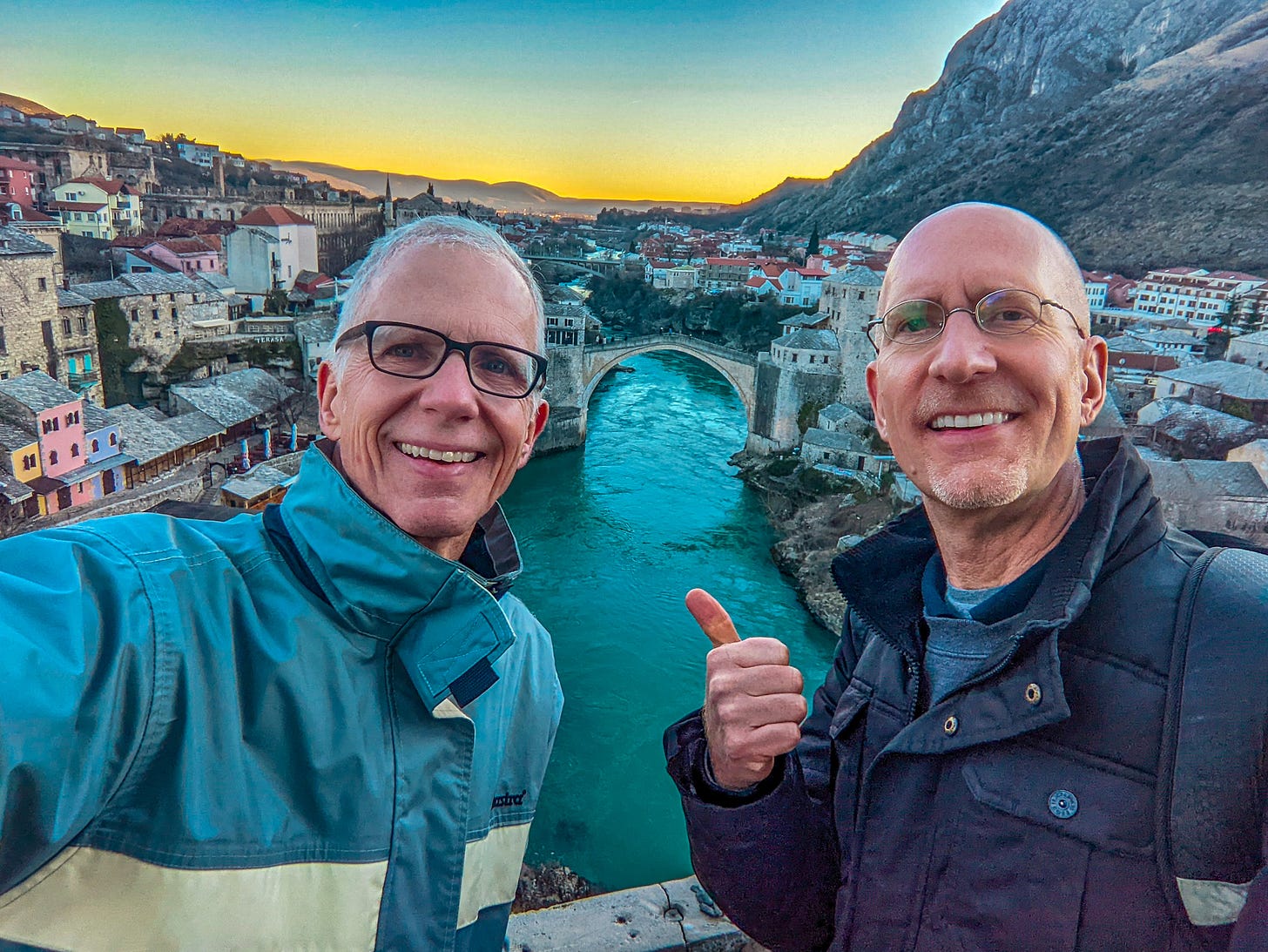



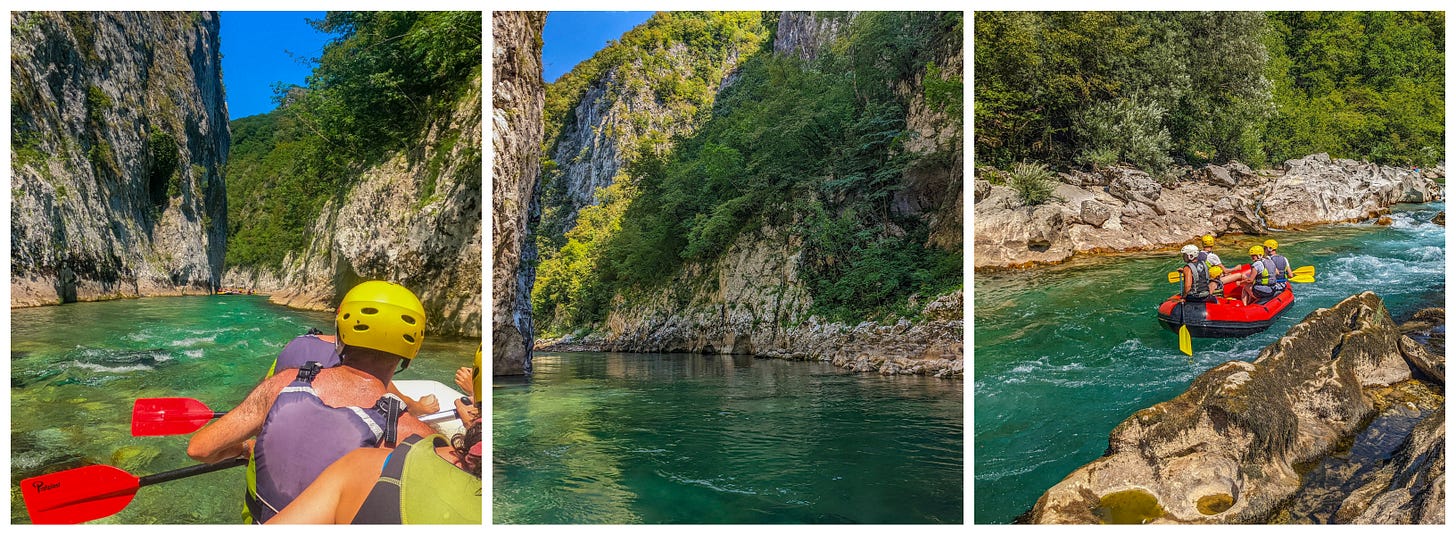
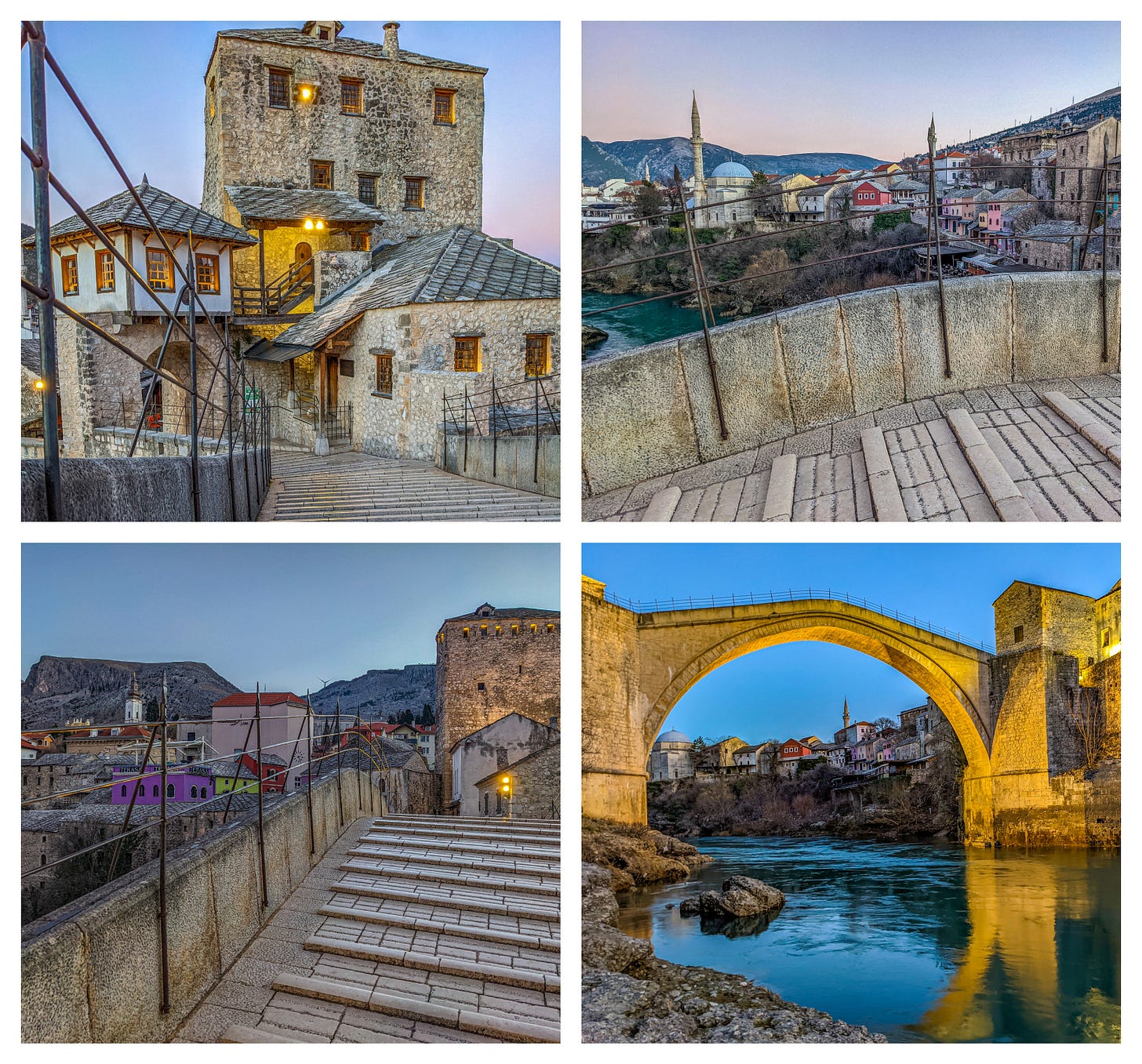
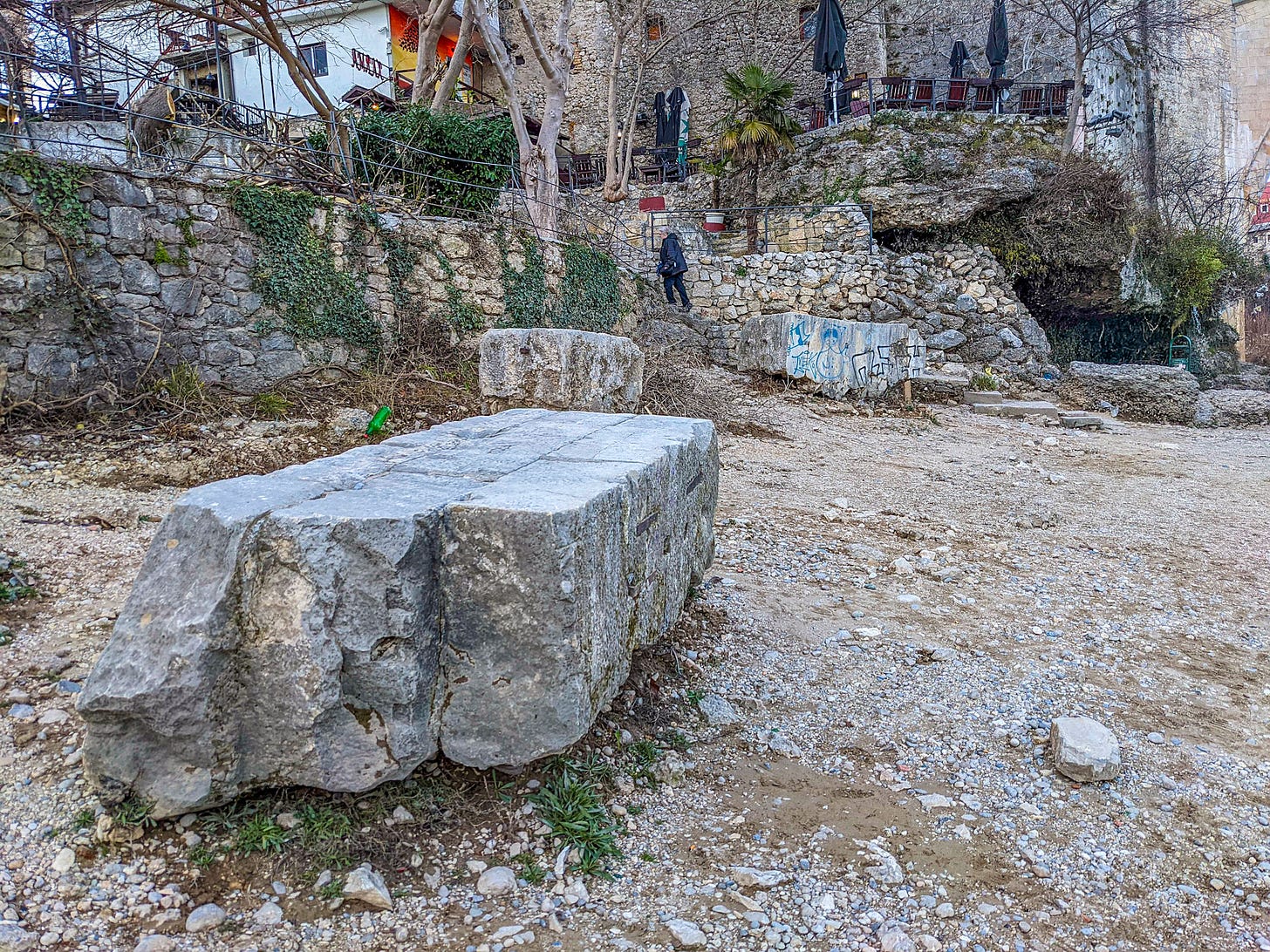
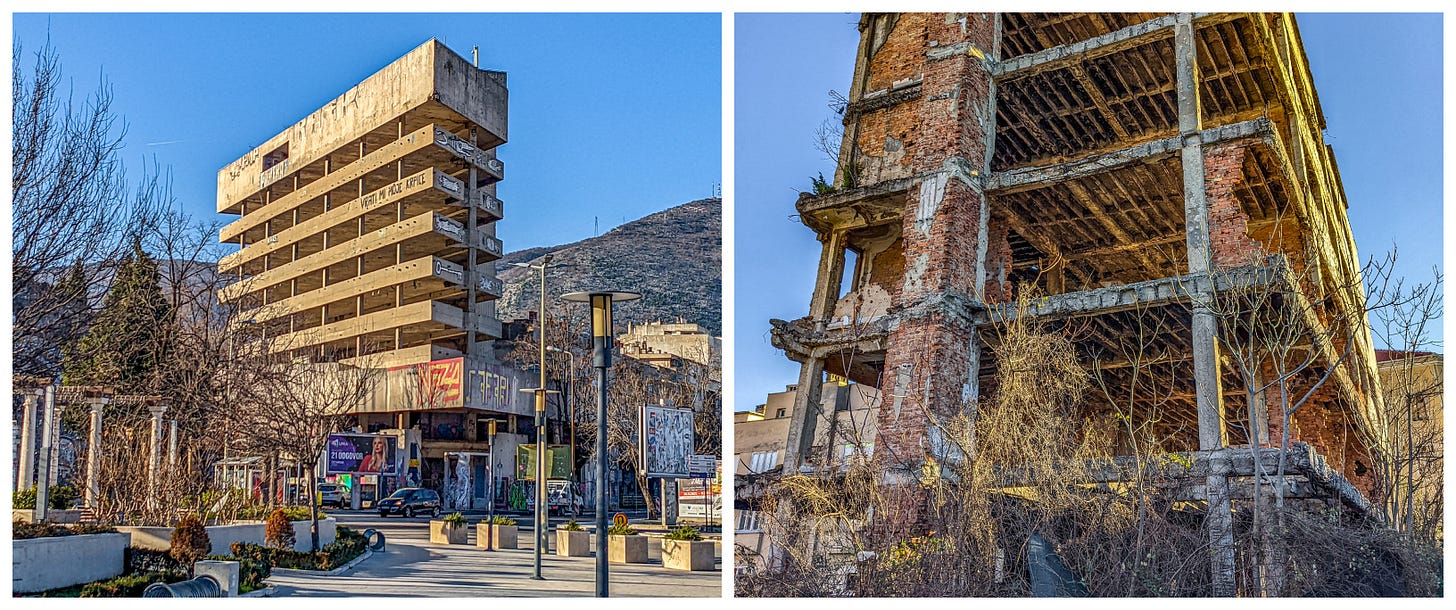
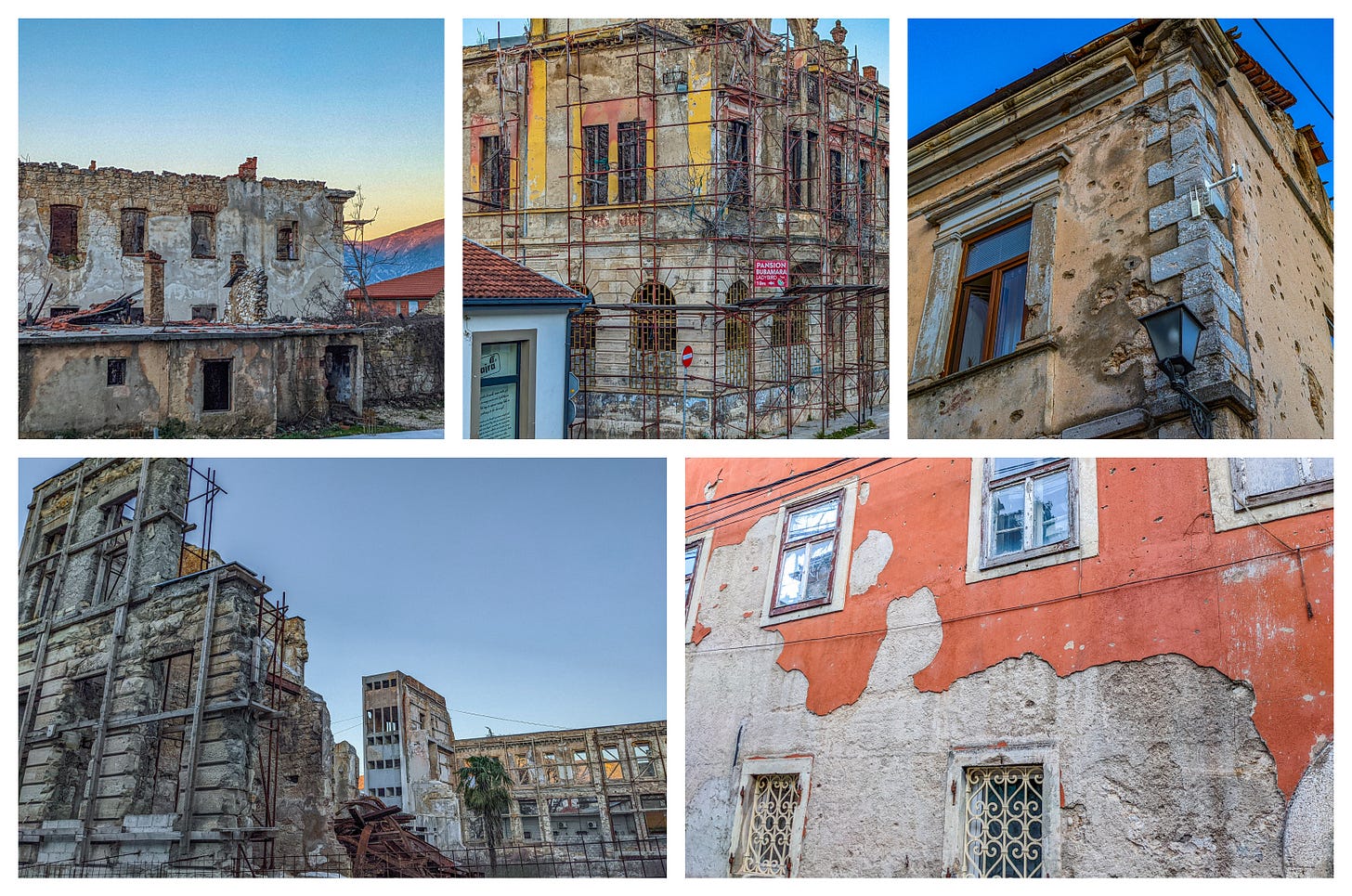
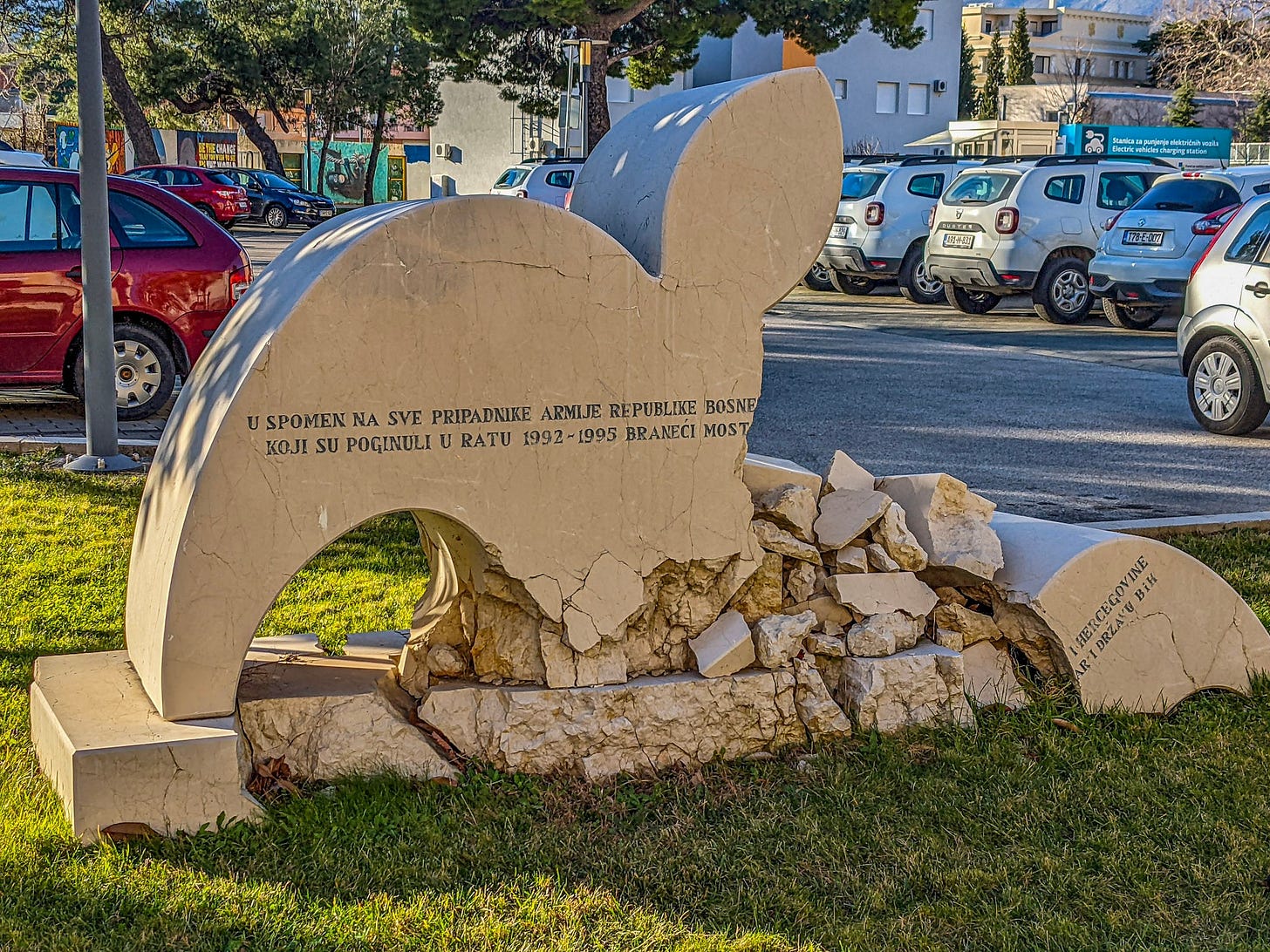
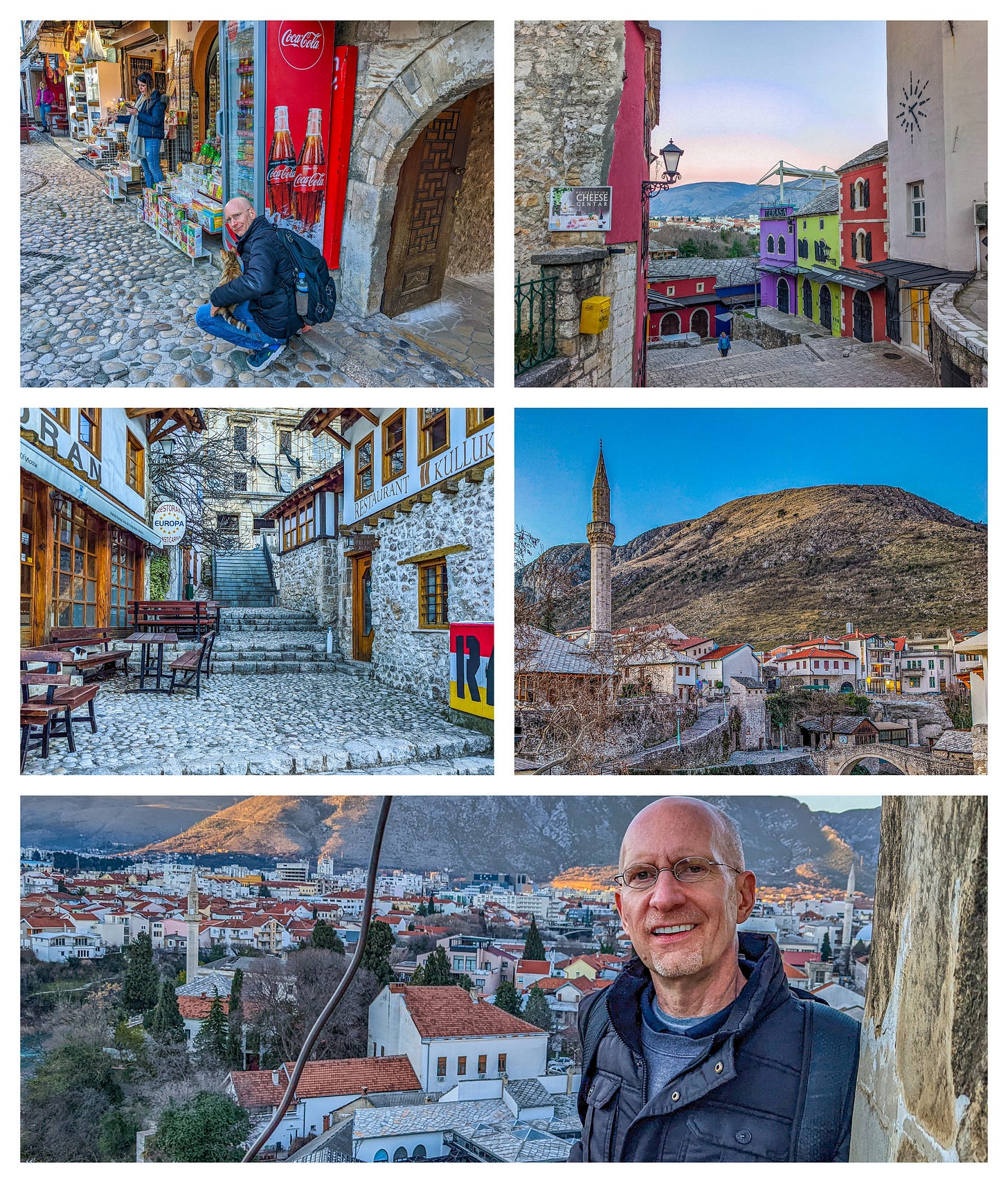
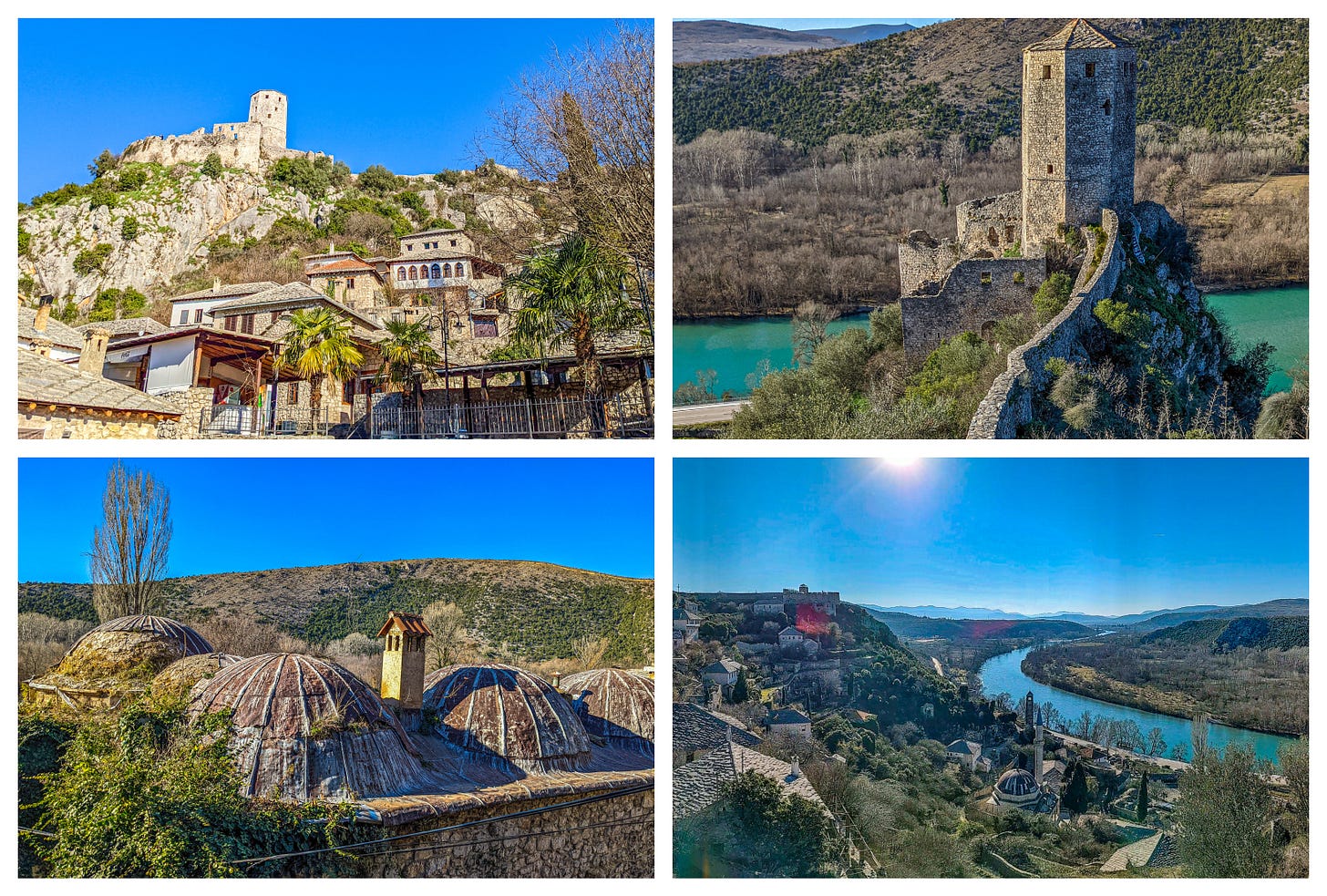

I'm currently reading Michael Palin's NEW EUROPE, about touring Europe in the early 2000s, and he first starts in Bosnia and Herzegovina, and talks about how their civil war in the 1990s is still very much alive in the minds and hearts of the people living there. Most of the people he met who took him around were former soldiers or insurgents....
I really love you guys! Writing this before I even read the article to give you the feedback of how much I love seeing a photo of the two of you together smiling with a beautiful background!! It makes me so happy to see you in my inbox! ❤️